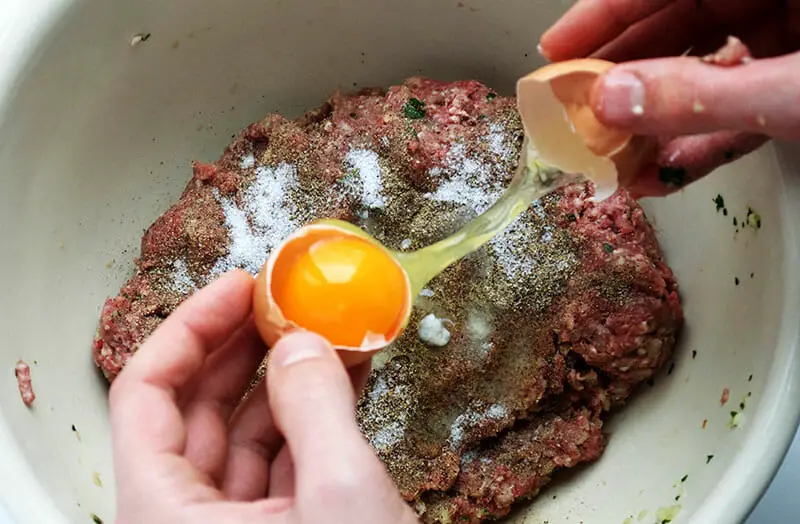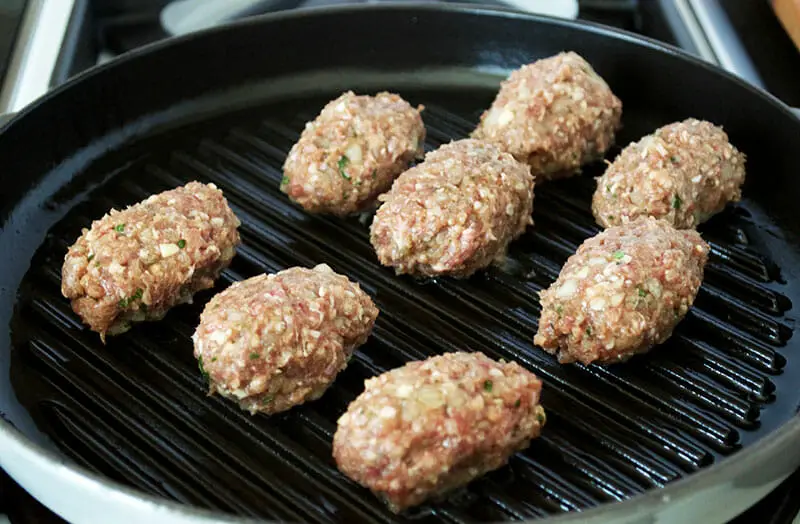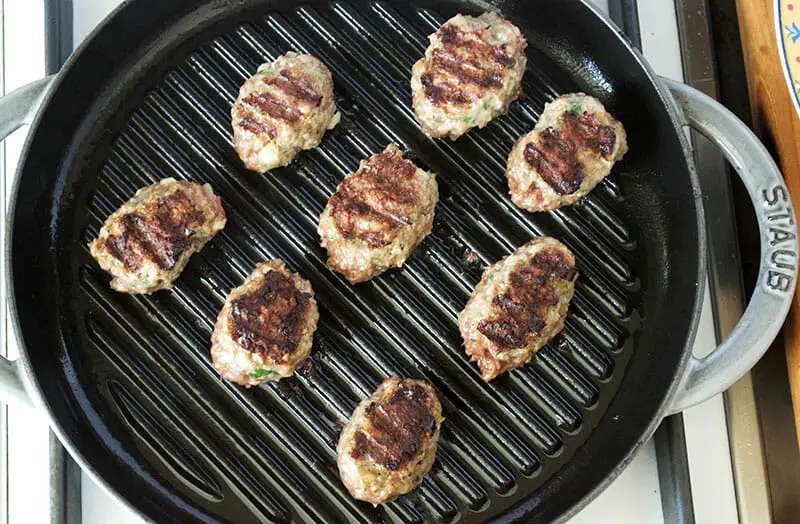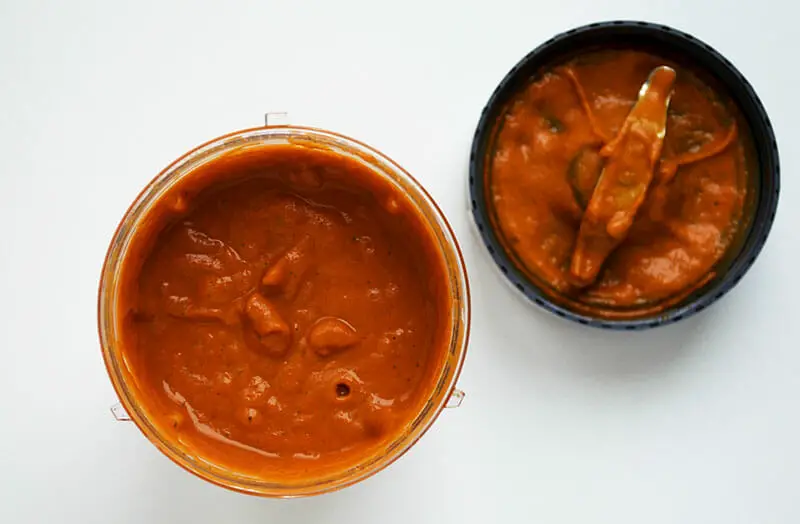Grilled pieces of meat or cubes of kebab are one of my favorite summertime foods. I love the simplicity, fun and flavor of skewered meats. This recipe is best served with flatbread.
What is Cevapi
Cevapi (or ćevapčići, if you want to be all diminutive and cute) are the seminal kafana food of the Balkans, cousins of the Turkish köfte and not too distant relatives of the Persian kebab.
Each area of the Balkans – from Romania to Albania and over to Greece – has its own take on the simple cevapi. There are variations on the kind of meat or seasoning used as well as the ćevap’s length (some two inches, some five). The one thing that holds them all together is their supremacy on the local menu… and how well they go with a beer!
Here, we present Bosnian rendition of cevapi, served on a flatbread (known as a lepinja) with a side of ajvar – the delicious roasted pepper relish.
And a beer, of course.

CEVAPI: WHAT THE OTTOMANS LEFT BEHIND
In general, the people of the Balkans don’t look back too fondly on their four centuries of subjugation to the Ottoman Empire, but the remnants of Ottoman rule still live on in modern Balkan states and have morphed into deep-rooted parts of the cultural landscape.
From their conquest of Bosnia in 1463 to their departure in 1878, the Ottomans got deep under the skin of their Balkan subjects. Converting a great deal of the Bosnian population to their Islamic religion, the Turkic overlords also put in place an extensive infrastructure of mosques, schools, forts, bridges and other institutional and monumental buildings. Many of these survive today and were lovingly restored after the Yugoslav wars of the 1990s.
Another place the Ottomans really made their mark was in the local kitchens. Balkan food today reverberates with Turkish influence, with dozens of dishes from the Ottoman repertoire taken and adapted to Balkan tastes. Sarme (stuffed cabbage and vine leaves) and pastries like cheese or spinach burek are ubiquitous just like Turkish coffee and baklava.
WHEN IS A KEBAB NOT A KEBAB?
Etymologically, the word ćevap (the local term for cevapi) evolved from the Persian kebab, meaning “grilled meat” or “meat on a skewer.” This term was adopted by the Ottomans and taken with them to the Balkans. Cevapi in form most closely resembles Turkish köfte and Greek souvlaki, but it still signifies a grilled patty of ground meat like a lamb kebab.
According to the 19th century Serbian literary hero (and we presume, a cevapi aficionado) Branislav Nušić, ćevapčići were beginning to make a show in Belgrade’s kafane by the 1860s, famously in the Rajić kafana in Serbia’s capital. Here they became a favorite with the drinking crowds and their popularity soon spread.
As you move through the Balkan region, however, the cevapi will vary. Leskovac in Serbia is well known as being one of the best towns to grab a plate of meaty fingers, and their namesake preparation has spread throughout the region.
FUELING THE REBELLION
Another popular variation is the pork Hajdućki ćevap, a dish season with salt of insurgency.
The Haiduks were bandits who resisted the occupying Ottoman forces by providing an alternative military presence in the Balkans as gangs of ersatz Robin Hoods. They would hide in the mountains and forests and pounce on traveling groups of Ottoman officials, as well as rich Christians and Jews, and rob them of their valuables. In the 19th century, many of them stepped up to join the Balkan National Liberation Movements.
All this banditry, rebellion and living undercover of the mountains worked up an appetite in the brigands, who, according to legend, would nourish their numbers by grilling small sausage-shaped pieces of minced pork and smoked lard over an open fire, thus spawning the Hajdućki Ćevap.
AJVAR – What to Serve With Cevapi
This recipe of mini grilled sausage is best served with a roasted pepper relish called “Ajvar – on a flatbread.
Ajvar is a type of food called a ‘zimnica’ in the former Yugoslav states, meaning a winter preparation. Come September, when eggplants and peppers are ripe and piled in sky-high abundance at local market stalls, cooks come and buy them up by the crate load to take them home and make various preserves for the coming winter months. So important is this ritual (and so enormous a task) that it’s not uncommon to see entire families out in the forested parks lighting fires and roasting their pepper harvest en masse to save on time and electricity bills.
Depending on how your ajvar comes out, you might find its thick, lumpy consistency reminds you a bit of caviar. The word ajvar is actually derived from the Ottoman-Turkish word havyar, or caviar. Caviar itself was a staple in the times of the Empire – the large amount of sturgeon in the Danube meant that roe was plentiful – and it was considered a poor man’s food. Overfishing has now made the fish a highly endangered species, increasing the scarcity and repositioning the value of caviar as a luxury item.
As such, ajvar is the new Balkan caviar, spread on bread or eaten as a side dish with your favorite grilled meat.
ABOUT THE RECIPE
If you’ve got time, the optimum time to start making cevapi would be the day before you need them. The best cevapi are mixed, prepared, then left in the fridge overnight to really work up their flavor before being grilled the following day. But if you don’t have several days to prepare dinner, rest assured that the whole thing can be done in one sitting and still taste marvelous.
We recommend starting with the ajvar by broiling the bell peppers and eggplant.

Switch your broiler on high and place an oven tray as close to the heat as possible. Just leave enough height for the vegetables. There is no need to cut the vegetables before grilling them. Go ahead and place them whole on a hot grill pan or a baking sheet lined brushed with olive oil with aluminum foil.

The grilling is a fast and assiduous process: stay present and keep an eye on the vegetables. They will need turning quite frequently as the high heat of the broiler burns their skin quickly.
Do let them blacken and blister. This loosens the skin and will later allow you to peel the peppers and eggplant much more easily.
Once done, take them out of the oven and leave them to cool.

PREPARING YOUR CEVAPI: A MEAT MELANGE
Beef is traditionally the base ingredient. Sometimes people use cubes of lamb, chicken pieces, chicken breasts or pork. This adds flavor and a different type of texture.
In our recipe we’re using ground beef and ground pork. If you like whole pieces of beef instead try our london broil beef kebabs (kyinkyinga), or other other recipe on Peruvian beef kebabs (anticuchos).
However, do feel free to replace the pork in our recipe with lamb shanks or chicken pieces. It will work just as well and add extra flavour.
Start your cevapi preparation by mincing the green onion, fresh garlic cloves and fresh parsley. Mix them in a bowl together with your meats of choice.

This is no time to be squeamish about raw meat! Clean your hands and get them in there, kneading and squishing the meat and other ingredients together. Use a ladle if you have to, but we prefer the manual cooking method!

Once evenly mixed, add the smoked paprika, ground pepper, cayenne and salt to the meat. Mix, knead and squish once more.
For the third round, add the remaining ingredients – the egg, baking soda and sparkling water. And mix.

HOW TO COOK CEVAPI
Before you start shaping the cevapi, start warming up your pan so that it gets nice and hot.
Take a small ball of the meat mixture and hold it in the palm of your hand to shape it. You can add a small amount of olive oil in your palm or virgin olive oil.
First, roll it into a ball, then start to lengthen it out by molding it with your fingers. It will up long and round, just like one of your own meat-covered digits.

Place each ćevap onto the grill pan using medium-high heat. Grill until the meat starts to get seriously brown and grill marks form. It should not take more than three to four minutes. Once done, take them off the grill and let them cool off for 10-15 minutes.


HOW TO COOK CEVAPI IN THE OVEN
You can cook Cevapi in the oven. Preheat oven to 360F and place the sausages on baking tray lined with parchment paper. Turn once after 10-15 minutes and repeat on other side. If they get a little dry, baste them with a touch of olive oil.
FINISH THE ROASTED PEPPER RELISH
By now, the peppers and eggplant should be cool enough and the skin should fall off with ease. In case it doesn’t, or you find it is sticky, try peeling them in a bowl of cold water.


You can chop and mince by hand, or use a food processor in chop mode. Add in the chopped onions, lemon juice and fresh parsley. The result is simply a much smoother paste. Throw in some lemon zest if you like!

One of the most traditional ways to consume a plate of cevapi is with chopped onions on a white bread roll. We prefer ours with flatbread and a dollop of ajvar. If you like, add some sour cream and pickled peppers – which is another habitual way of serving the dish.
And did someone mention a beer?
OUR TAKE ON THE RECIPE
We researched the web for the best Bosnian cevapi, and there were alot! We chose this recipe as our source because it ended up being most consistent with what we found elsewhere.
That said, we did take a few liberties and made some adjustments where we saw fit.
We also included the ajvar (roasted pepper relish) preparation in our recipe since it’s a Balkan classic. We used fresh lemon juice, and added paprika and cayenne to the cevapi and parsley to the ajvar.
For such a straightforward and already-delicious recipe, however, we did little else and let the recipe speak for itself.
Živeli!
(NOTE: Want to save this recipe for later? You can take home a downloadable PDF version of this recipe by clicking here.)

